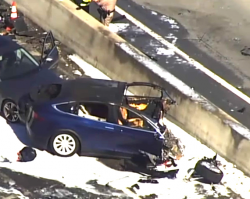
— A Tesla Model X that crashed and burned had its Autopilot system engaged when the SUV slammed into a California highway barrier, causing the front of the SUV to disintegrate and the battery pack to catch on fire.
The Model X driver, Wei Huang, was rushed to the hospital where he was pronounced dead.
Tesla says the data shows Autopilot was engaged with the adaptive cruise control follow-distance set to a minimum when the crash occurred on March 23, 2018.
Tesla says the driver received several visual warnings about keeping his hands on the steering wheel, in addition to an earlier audible hands-on warning. The warning was given after the system detected no hands on the wheel for the six seconds before the crash.
According to Tesla, the driver would have had about five seconds and 150 meters of an unobstructed view of the concrete divider he hit, but the driver did nothing to alter course. Neither did the Autopilot system.
Every Tesla owner's manual says Autopilot is not to be used unless hands are on the steering wheel, and without those hands the system will provide warnings to the driver, with the frequency of warnings determined by the speed of the vehicle.
And although Tesla pushes the safety of the system, the Model X owner's manual admits the system may fail to recognize lane markers or objects in the road. The manual tells the driver to be fully aware of what the SUV is doing at all times, something Tesla drivers seem to have trouble doing.
A previous crash that killed a Tesla Model S driver in Florida showed the driver never saw the car was heading straight into a tractor-trailer, and the Autopilot system never even slowed down the car. The 2016 crash that killed 40-year-old Joshua Brown got the attention of investigators with the National Highway Traffic Safety Administration (NHTSA) and the National Transportation Safety Board (NTSB).
After months of investigating, the NTSB report concluded Brown was relying on autonomous technology too much by not paying attention to the road. However, the report also found the Autopilot system suffered from a lack of safeguards, not to mention the system never saw the huge tractor-trailer crossing the highway.
Autopilot failed in every way, including failing to see huge objects in the road, a failure of the forward collision warning system to activate, a failure of the car to slow down and the final failure of the automatic braking system.
Following the March 23 Model X crash in California, Tesla quickly went on defense by pointing out images from the day before showed the highway safety barrier, known as a crash attenuator, had allegedly been removed without being replaced.
The missing barrier, which would have allegedly lessened any impact, is allegedly what caused the massive damage to the SUV that Tesla said it had never seen before in any other crash. Based on the crash scene, the entire front of the SUV disappeared from the impact (see photo at top right).
The automaker says its batteries are designed so that if a rare fire occurs, the fire should spread slowly to give occupants time to get out of the vehicle, but the Mountain View Fire Department had serious trouble with this fire.
Department officials said they typically are on the scene of a car fire a relatively short amount of time and able to douse a car fire within minutes. But the Model X fire caused them to spend more than six hours dealing with the battery of the electric SUV. About 7,000 cells are used in the Model X battery, with each cell capable of catching on fire.
Fire departments are recommended to put about 3,000 gallons of water on the fire or let it burn itself out. However, damaged cells can still catch on fire 24 hours after the initial fire, causing massive headaches for fire departments. Additionally, first responders to the crash were concerned about getting shocked due to the battery pack.
The Model X crash follows a January 2018 crash that involved a Tesla Model S that crashed into a firetruck, with the driver claiming Autopilot was engaged because the driver had been drinking. The investigation into that crash continues.
Other Tesla drivers have complained Autopilot was engaged when the crashes occurred, crashes that should have never occurred if the system was working properly. A few of those incidents have occurred in China, with one that involved a Model S that crashed into a highway street sweeper.
The crash killed 23-year-old Gao Yaning and video shows he had plenty of time to avoid the crash, yet no evasive action was taken. His family claims this shows he was relying on the Autopilot system which apparently failed. Tesla couldn't figure it out because the crash allegedly destroyed all the crash data.
Another China crash of a Model S allegedly occurred with Autopilot engaged when the car hit a parked vehicle. Chinese authorities reported the driver believed Autopilot meant "self-driving" and accused Tesla of marketing the Model S as a self-driving car when it wasn't. At this same, Tesla changed wording on its Chinese website that previously used a Chinese word that meant "self driving."
The National Highway Traffic Safety Administration (NHTSA) and the National Transportation Safety Board (NTSB) sent investigators to California to determine how and why the Model X crashed and caught on fire. Both agencies are currently working on a separate self-driving crash that killed an Arizona woman.
CarComplaints.com will update our website with results of the federal investigations.




